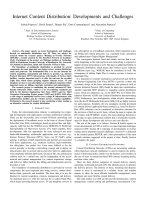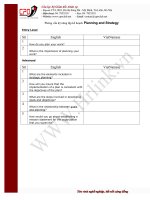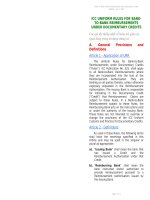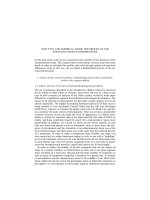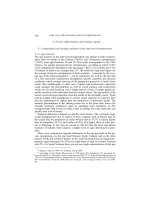Tài liệu Tips on Applying for and Passing the PMP or CAPM Exam pptx
Bạn đang xem bản rút gọn của tài liệu. Xem và tải ngay bản đầy đủ của tài liệu tại đây (151.09 KB, 10 trang )
Tips on Applying for
and Passing the PMP
®
or CAPM
®
Exam
1-800-COURSES
www.globalknowledge.com
Expert Reference Series of White Papers
Introduction
The Project Management Institute’s (PMI)
®
Project Management Professional (PMP) certification is hot right
now, and the Certified Associate in Project Management (CAPM) is growing in popularity as well. With just
over 212,000 Project Managers worldwide (as of October 2006) having received the prestigious PMP certifica-
tion, the field is growing. The number of Project Managers getting certified is growing every year, as more
companies than ever are requesting, and in some cases requiring, their Project Managers to become certified.
With the current economic environment,
certification helps Project Managers differentiate themselves from
their co-workers or other job applicants. Having a certification also lends credibility to the Project Manager,
ensuring the client or organization that the fundamentals of successful project management are understood.
As organizations become more sophisticated in their application of Project Management (PM) principles, more
consistent and successful processes are desired. To implement these processes, organizations are relying more
heavily on certification for their Project Managers as well as creating Project Management Offices
, where indi-
viduals are often required to become certified.
This white paper discusses the following:
• The application process to apply to take either the PMP or CAPM exam
• Tips to make the application process less arduous
• The make-up of the exam questions
• Tips for successfully passing the exam
• Requirements to maintain certification
PMP Exam Requirements
While the requirements necessary to be eligible to take the PMP exam are listed on PMI’s website at
they are also covered here
to provide all the pertinent information condensed and in one place
.
T
his site provides a PDF of the PMP
Handbook, which contains the requirements to qualify to take the PMP exam and the application form. Even if
you intend to submit your application on-line, which is the preferred method, I suggest using the paper form to
compile and organize the information beforehand.
Once it is compiled,
actual entry of the information goes
very quickly.
Applicants with a bachelor’s degree or global equivalent must meet the following requirements (a masters
degree or higher does not decrease the following requirements):
• Minimum 4,500 hours PM experience
• Minimum 36 months PM experience within the prior 72 months
• Minimum 35 contact hours of PM instruction
Vicki Wrona, Global Knowledge Instructor, PMP
Tips on Applying for and Passing the
PMP
®
or CAPM
®
Exam
Copyright ©2007 Global Knowledge T
raining LLC. All rights reserved. PMI, PMP
, CAPM, and
PMBOK are registered trademarks of the Project Management Institute, Inc.
Page 2
A
pplicants who do not have a bachelor’s degree, but instead have a high school diploma, associate’s degree,
or global equivalent, must meet the following requirements (notice the only real change is to increase the PM
experience needed and, of course, the time allowed to get that experience):
• Minimum 7,500 hours PM experience
• Minimum 60 months PM experience within the prior 96 months
• Minimum 35 contact hours of PM instruction
Contact hours can be obtained through a university or college, by a course offered by a PMI-recognized
Registered Education Provider (REP) such as Global Knowledge, by employee-sponsored classes, or by a train-
ing company or consultant.
Some potential applicants misunderstand the requirement for PM experience. This includes not only experience
as a Project or Program Manager, but also experience working on projects from other vantage points, such as
in the role of a team member, Subject Matter Expert (SME), Sponsor, etc. PMI’s newer terminology states that
candidates have experience leading and directing project tasks, the details of which are explained in the PMP
Application section below
.
PMP Application
Documenting your personal PM experience will be the most difficult part of the application process
. PMI
requires the following information for each project:
• Project name
• Date range
• Your role on the project
• Your job title
• Organization name and address
• Contact information of a reference who can verify work experience
• Total hours spent on the project
• Hours Spent in the following:
•
Initiating
- Conduct project selection methods
- Identify key stakeholders
- Define scope
- Develop, review, and approve project charter
- Identify and document risks, assumptions, constraints
•
Planning
- Define roles and responsibilities
- Create work breakdown structure
- Define risk strategies
- Obtain project plan approval
- Define detailed project requirements
- Develop change management plan
•
Executing
- Manage resource allocation
- Execute tasks
- Set expectations
- Improve team performance
Copyright ©2007 Global Knowledge T
raining LLC. All rights reserved.
Page 3
-
Implement quality management plan
- Implement approved changes
- Obtain project resources
- Implement approved actions and workarounds
•
Monitoring and Controlling
- Measure project performance
- Verify and manage changes
- Monitor status of risks
- Ensure deliverables conform to quality standards
•
Closing
- Obtain formal project acceptance
- Perform lessons learned
- Archive project records
- Obtain project closure
- Release resources and provide performance feedback
- Distribute final project report
- Measure customer satisfaction of the project
•
Summarization of project tasks led and deliverables managed by process group
This information is found on pages 4 and 5 of the PMP Credential Application.
TIP: To expedite the calculation of the detailed break
out of hours by category
, use an Excel spreadsheet. If you
do not have a current and complete list of the projects you have worked on over the prior five years or so,
start with your resume and list all the projects you have worked on along with their date ranges. Once you
have filled in all the gaps of time
, estimate the number of hours per week you spent on each project, and then
extend that to the number of hours per month. Multiply the monthly hours by the number of months to get
your total hours worked on a project.
(This is where an Excel spreadsheet will come in handy.)
Make sure your estimate of hours truly indicate the hours spent on the project, not just at work. For example,
if you are lucky enough to only work 40 hours per week, it is not realistic to assume all 40 hours were spent
on the current project, as some time will be spent on administrative tasks, other meetings, your ‘real job,’ per-
sonal issues, etc. If you have a university degree, PMI states that experience should be gained over a minimum
of three years and a maximum of six years. In other words, you cannot state that you have 5,000 hours of
experience gathered in two years.
T
hen, estimate the percent of time spent in each Process Group (Initiating, Planning, Executing, Controlling,
Closing), tweaking the percentages until they add up to 100%. Let Excel then calculate the number of hours
per Process Group. Then, estimate the percentage of your time spent in each activity within each Process
Group, ensuring that the total percent for each Process Group adds up to 100%. Again, let Excel calculate the
hours spent on each task within the Process Groups
.
T
he individual numbers are what you will input into the
online application,
and the system will add up the total hours on each project.
Approximately 10% to 15% of applications are randomly selected for audit. Once your application has been
approved, PMI will send an authorization letter, allowing you to schedule your exam. Once the authorization
letter is received, you have one year to take the exam.
Copyright ©2007 Global Knowledge T
raining LLC. All rights reserved.
Page 4
CAPM Exam Requirements
The requirements to take the Certified Associate in Project Management (CAPM) exam are listed in the CAPM
Handbook located on PMI’s website at
The CAPM certification is
a newer certification; currently, approximately 1,500 people have attained the CAPM certification (as of
October 2006). It is designed for practitioners who do not have enough PM work experience to meet the PMP
qualifications, yet still allows them to obtain some sort of certification while they are gaining the necessary
experience.
Applicants with a high school diploma or equivalent must meet the following requirements:
• Minimum 1,500 hours of work on a project team
OR
• Minimum 23 contact hours of PM instruction
As with the PMP process, once your application has been approved, PMI will send an authorization letter,
allowing you to schedule your exam.
Once the authorization letter is received, you has one year to take the
exam.
CAPM Application
If you choose to document experience rather than PM education on the CAPM application, the process is much
simpler than on the PMP application. For every project, the following information is needed:
• Project name
• Date range
• Your role on the project
• Your job title
• Organization name and address
• Contact information of a reference who can verify work experience
• Total hours spent on the project
• Hours Spent in the following:
• Initiating
• Planning
• Executing
• Monitoring and Controlling
• Closing
• Project team experience summarized by process group
Examination Fees
Your status at the time you begin the online application process determines the fee that will be charged to
take the exam. The fees are as follows:
Copyright ©2007 Global Knowledge T
raining LLC. All rights reserved.
Page 5
